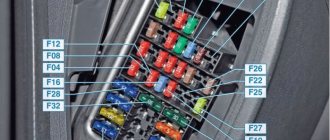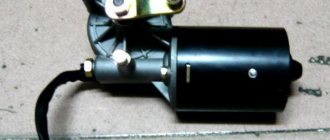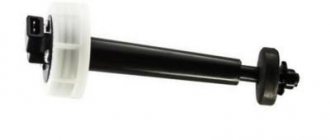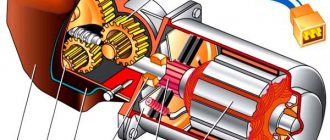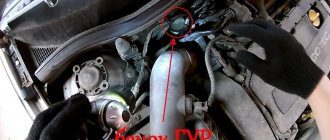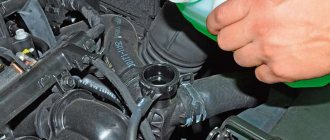An integral element of the brake system is a reservoir with working fluid. It ensures the presence of a sufficient amount of fuel fluid in the circuit. The tank is hermetically sealed with a lid, which prevents moisture from being absorbed by the hygroscopic liquid.
Appearance of the brake fluid reservoir
Where is the glass washer reservoir located and where should I fill the washer fluid?
When we press the windshield washer lever, a small motor under the hood of our car drives an equally small pump.
As a result of this, the washer fluid from the reservoir is pumped into the washer nozzles - these are small protrusions with holes on the hood, directed towards the windshield. It is from there that, under the pressure created by the pump, the “washer” or, as it is also called, “anti-freeze” sprays. Let's find out what to do if the washer suddenly runs out. Where can we find the washer reservoir under the hood and where can we fill in the new anti-freeze agent? Firstly, during the autumn-winter-spring seasons, it is best to always have a supply of washer fluid in the trunk of 2-4 liters. It’s very unpleasant to find yourself in slushy weather without it and without the prospect of finding an auto shop within the next few kilometers. The second thing you need to know is that there are summer and winter washer options. The first is much cheaper, but freezes at low temperatures, while the second usually remains liquid down to -30 degrees. Therefore, it is necessary to choose one or another type of anti-freeze based on weather conditions. Remember that in some cases, frozen washer fluid (especially poor quality) can lead to destruction of the nozzles and their subsequent replacement.
So, where do we fill the antifreeze and where is the washer reservoir located in our car? The answer to this question is quite simple. In 99% of cases, the washer fluid reservoir is located under the hood. Therefore, the first thing to do is to pull the hood release lever (as a rule, it is located at the level of the left knee with a picture of an open hood on it). Then we go out, lift the hood lid and fix it using a special holder lever - you can also find it without any problems - usually it is inserted into the latch on the raised hood lid itself.
Next, we look for where the washer reservoir is located. Standing in front of the car, look at the left side of the engine compartment (relative to you); in almost all car models it is located immediately behind the headlight. The washer reservoir is a white or translucent tank with approximately 3.5-5 liters of anti-freeze.
And its lid will help us more specifically and accurately identify the washer reservoir. It is often blue or cyan in color, but can also be yellow or black. And it shows a windshield with a splashing washer. And we can make sure that this is the tank we need by assessing its contents - after all, since we have run out of glass washer, it should be empty (except in rare cases of clogged nozzles or a breakdown of the motor or pump of the washer system).
So, we have decided where to fill the washer fluid. You simply open the lid (usually it just snaps on, less often it unscrews) of the washer reservoir and the cap of the bottle with a new anti-freeze agent and begin to carefully pour in the contents of the bottle, trying not to splash the washer on other units and parts. If you suddenly splash something, then look to see if there are any wires coming off of it. If not, then everything is fine. It is also undesirable for the washer to get on the drive belt - this (however, in very rare cases) can worsen its performance.
Source
Design and operation
The expansion tank consists of a polypropylene body, a cover and two pipes for connecting hoses of the liquid system. Using the lower hose, the device is connected to the cooling line, the upper one serves to remove vapors and air bubbles from the system. On modern models, float coolant level sensors are often installed.
For this option, the expansion tank is equipped with another neck on top, intended for installing a sensor. Several control marks are applied on the side surface of the container, from the bottom - min to the top - max. The coolant level should be located in this interval.
How does the device work? First, a little theory. The table shows the operating temperature conditions of modern engines. As we can see, the engines operate in critical temperature conditions.
| Engine temperature, °C | Working | Short term |
| 80 — 100 | 120 — 125 | |
| Boiling point of liquids, °C (at atmospheric pressure) | water | 100 |
| antifreeze | 105 — 110 | |
| antifreeze | 120 |
To raise the bar for permissible temperature, designers increase the pressure in the coolant (more than atmospheric), due to which its boiling point increases. To do this, the system is closed hermetically and excess pressure is maintained in it. For different engines, this value ranges from 0.1 to 0.5 bar (kg/cm²).
At the same time, significant vacuum (more than 0.03 - 0.1 kg/cm²) in the free space of the expander is unacceptable, since air will be sucked into the system, which will lead to the appearance of air pockets that impede coolant circulation and, consequently, to engine overheating . Maintaining the coolant pressure at the required level is the responsibility of a special regulator located in the filler cap.
How to replace windshield washer fluid in the reservoir
In winter, driving conditions become more difficult - strong temperature changes, snow, ice, slippery road surfaces, freezing of technical fluids, etc. A separate issue is the deterioration of road visibility due to ice or dirt freezing on the windshield. To clean the glass, the car has a glass washing system: an electric pump that supplies windshield cleaning fluid from the washer reservoir through rubber lines and nozzles directly to the windshield.
In summer, ordinary water is sufficient in the windshield washer system, but in winter frosts (especially at temperatures from -25C) it is necessary to fill the washer reservoir with a special low-temperature windshield washer fluid (water + alcohol), which does not thicken and does not freeze in severe frosts, wets the glass surface well and quickly removes ice and dirt from it.
Checking the functionality of the lid
Simplified test: are the valves working?
We start the engine and, being careful, unscrew the cap: if you hear the hissing sound of a deflated chamber, the bypass valve is working (however, whether it is correct or not is unknown).
After removing the cover, squeeze any hose of the cooling system with your hand. Continuing to hold it in this way, put the cover in place. If it then regains its shape, the vacuum appears to have been filled. But if, even before starting the engine, the hoses look like they are flattened, the vacuum valve is definitely not working.
More accurately, the safety valve can be checked using a pump and pressure gauge. We connect the pump to the lower supply pipe of the tank, and plug the upper one using improvised means: a bolt or a cylindrical drill that fits tightly into the supply hose.
We create pressure with the pump and control the moment when the safety valve is activated (hissing sound). The pressure value recorded on the device scale shows the actual response pressure.
If the safety valve is too tight, it can be repaired. Why spend extra money when it is enough to shorten the pressure spring by one or two turns, and the spring will become softer. The assembly is easy to disassemble, the main thing is not to lose small parts. And don't overdo it by biting off the coils. Do this little by little and check the results.
When should you add anti-freeze?
In modern cars, the glass washing system is designed not only to clean the windshield, but also to wash the headlight optics of the car. Therefore, only clean water is poured into the washer reservoir in summer, and non-freezing liquid with high cleaning capabilities in winter - in winter highway conditions you should have a good view of the road and clean headlights.
When should such a liquid, which is called “anti-freeze”, replace water in the washer reservoir? First of all, at the end of the warm summer-autumn season, when cold weather sets in and frosts approach. Do not wait until the water in the windshield washer system freezes one morning - this can lead to ruptured lines, broken pump impellers and damage to the washer reservoir. If you don’t want to repair the entire system, drain the water and fill it with anti-freeze before negative air temperatures appear outside.
In addition, it is necessary to fill in anti-freeze in several other situations:
- as the liquid in the tank is consumed (topping up);
- if necessary, replace the liquid with a more frost-resistant anti-freeze (concentrated liquid with a high alcohol content is more resistant to severe frosts);
- when the windshield washing system freezes (completely drain and replace or add hot water);
- when filling with low-quality anti-freeze (also complete drainage).
Another option: adding a more concentrated liquid to a diluted anti-freeze solution (withstands frosts down to -5C) when it gets colder.
Purpose of expansion tank
The cooling systems of various cars contain from 5 to 20 or more liters of non-freezing liquid - antifreeze (antifreeze). During operation, the engine, and along with it the antifreeze, heats up from low temperatures in winter to high temperatures in summer.
The temperature difference can reach 100 °C or more. For example, when operating a car in northern regions, where engine warm-up starts at minus 20 °C and ends at an operating temperature of 90 °C, this difference will be 110 °C.
During engine operation, a pressure of about 1 bar arises in the expansion tank
Since any liquid expands in volume when heated, excess is formed in the cooling circuit of the car, which needs to be directed somewhere. Antifreeze is an incompressible medium, so when it expands, it will create high pressure in the system, which can rupture the pipes and radiator honeycombs. Conversely, when cooled, the liquid will decrease in volume and create a vacuum (vacuum), which acts with the same force.
Read also: Why do we need feelings? ⋆
To ensure normal operation of the power unit cooling system and avoid pressure surges, an expansion tank is integrated into it. Its functions are as follows:
- absorb additional volume of antifreeze that expands when heated;
- release excess pressure through a plug with a built-in safety valve;
- release the fluid back into the system when the engine cools, preventing the formation of air locks.
Large expansion tanks are used on trucks
Antifreeze, which is a mixture of distilled water with ethylene glycol (sometimes propylene glycol), adds about 5% in volume when heated from zero to 100 °C. In a circuit designed for 10 liters of antifreeze, after complete warming up, as much as 500 ml is formed, which goes into the expansion tank.
How to choose the right antifreeze liquid
Antifreeze is a liquid based on water and alcohol, and the higher the content of the latter in the solution, the lower temperature it becomes (at 50% content it can withstand temperatures down to -30C). In severe frosts, therefore, liquid concentrate should be poured into the washer reservoir, and at -5-10C you can dilute the anti-freeze with water.
Today there are many windshield washer fluids on the market from various foreign and domestic manufacturers, with different chemical compositions and conditions of use. How not to make a mistake with your choice, buy an anti-freeze product with the required crystallization limit (freezing temperature) and not stumble upon a counterfeit product?
Read the labels on windshield washer fluid containers! It should indicate:
- crystallization (freezing) temperature – from trusted manufacturers on the packaging it is indicated for the concentrate with a margin of several degrees;
- kinematic viscosity - fluid fluidity and thickening conditions (thickened antifreeze clogs the nozzles);
- surface tension coefficient - the ability of a liquid to wet surfaces and impregnate dirt (the higher the better);
- surfactant content (surfactants) – the less, the better.
A separate and very important characteristic is the type of alcohol used in the solution. Ethyl alcohol is considered the highest quality and most expensive, the most popular is inexpensive and effective isopropyl alcohol, the most dangerous to human health and prohibited in legal production is methyl (methanol).
Counterfeit anti-freeze products are easy to identify: if they have no odor, they are dangerous and toxic methanol. If the smell is very strong and unpleasant, it is also a counterfeit product with “flavoring” additives. Ethanol antifreeze smells like vodka, isopropyl liquid has a slight smell of acetone. At the time of buying. Check liquids for smell!
Advice: even if you bought a well-known brand of anti-freeze (for example, Hi-Gear, Liqui Moly, Effect Plus, “Clean Mile”, etc.), and the seller is reliable, do not rush to fill the washer reservoir full! Firstly, today it is easy to stumble upon counterfeit liquids, and secondly, there is no guarantee that you have not made a mistake with the freezing temperature. First fill in 1-1.5 liters - in case of an error, it will not be difficult to drain them later.
Design and principle of operation
Modern expansion tanks for cars are a reservoir made of durable thick-walled plastic with a filler neck and fittings for connection to the elements of the cooling system. The shape of the tank does not matter functionally, so manufacturers customize it to fit the location of the tank.
The shape of the tank depends on the location of its installation and can be different - round, rectangular or flat
The capacity of the container for expanding antifreeze is calculated for each car model and depends on the total volume of liquid in the pipes and units. Moreover, in a cold state, the tank is only half filled with antifreeze, the rest of the space is occupied by air that can compress under pressure. The neck of the tank is closed with a plug with a built-in air valve. The principle of operation of the container is as follows:
- When the engine is “cold,” the tank is half empty—the antifreeze level is between the minimum and maximum marks on the body.
- After starting the engine, the antifreeze begins to expand and its level in the vessel rises, and the air gap contracts. The lid valve remains sealed.
- When the liquid reaches an operating temperature of 90–95 °C and a maximum increase in volume, the pressure in the tank reaches the air valve response threshold (1–1.2 Bar or 120 kPa). It opens and releases air into the atmosphere.
- As the engine cools down, the opposite picture is observed - the valve allows air to flow in the opposite direction until the amount of antifreeze stops decreasing. This prevents air locks in hoses and radiators.
The design of the container is quite simple - the tank body is closed with a stopper with a built-in valve
In an emergency situation, when antifreeze or water begins to boil for various reasons, the safety valve releases not only air, but also steam.
The built-in sensor sends a signal about insufficient fluid level to the instrument panel
In some car models, for example, VAZ 2110-2115, the container is equipped with a second neck into which the coolant level sensor is screwed. If, due to a breakdown or leakage of a component, antifreeze begins to leak out and its level in the container drops to a minimum, the sensor will operate and warn the driver with a signal from the corresponding light on the instrument panel.
There are cars (both domestically produced and imported) in which the expansion tank is closed with a simple plug, not equipped with a valve and communicating with the atmosphere. In such systems, the function of releasing pressure and re-injecting air is performed by the main radiator cap, and the reservoir only compensates for the expansion of the liquid.
The radiator cap is equipped with a bypass valve that directs excess antifreeze into the expansion tank
What you need to know when replacing a windshield washer
Maintaining the windshield washer system does not require much effort, but it is better to monitor and service it regularly to prevent blockages, traffic jams or ice from appearing in the winter. Important to remember:
- The system should be pumped periodically to remove air and water from it. This should be done before each new anti-freeze fill.
- There should always be a container with 3-4 liters of windshield washer fluid in the trunk to top it up if the reservoir is empty in the middle of the road.
- There is no need to fill the washer reservoir to the top. If the anti-freeze suddenly freezes, you should have room in the tank to add hot water, alcohol or anti-freeze concentrate to melt the ice.
- Antifreeze concentrate can be diluted if there is no serious frost or thaw outside, but the liquid and water should be mixed not in a tank, but in a separate container. This way you will protect the system from accidental incompatibility of components and will be able to control the concentration of the finished solution.
- If you accidentally poured low-quality anti-freeze into the tank, you should drain it completely. If you poured in a liquid with an inappropriate freezing point, you can simply add concentrate.
Location of the Republic of Belarus
To check the expansion tank cap valve, you need to know where it is located, which is difficult for some beginners. If we take into consideration domestic transport from the largest manufacturer AvtoVAZ, then, depending on the specific model, it may be in different places.
For example, in the VAZ-2110-12 line, the reservoir is located on the driver’s side (in relation to the vehicle’s travel) between the shock absorber strut and the interior partition. For VAZ-2114-15 models, the container is also on the left side, but is placed behind the glass of the counter. The Audi 80's tank is located approximately there.
Let's sum it up
As we were able to tell you, the expansion tank is found on almost all types of cars. Its reliability directly depends on operating conditions and temperature changes and the condition of the valve inside the lid. Do not pour refrigerant into a heated reservoir, otherwise you may damage the integrity of the entire system.
The cooling system of a modern car includes several elements, without which its normal functioning is impossible. These include an expansion tank, installed in different places under the hood depending on the make of the car. A simple plastic reservoir with a plug plays an important role in the operation of the engine cooling circuit and requires periodic monitoring by the car owner.
Why do you still need an expander tank?
As we know from the physics course, expansion of bodies such as antifreeze takes place. As the car engine heats up, the coolant expands, which over time promotes displacement. The expansion tank plays the role of a reservoir into which an increasing volume of liquid will flow. If antifreeze or other coolant is poured into a cooled radiator until it is full, then as the engine heats up, the antifreeze will be forced out of the reservoir.
On many cars, the cap of the expansion tank plays the role of a pressure regulator, since if excess antifreeze flows in large quantities, the valve located on the cap will release the excess pressure. This function is primarily necessary to ensure the integrity and safety of the engine cooling system.
As the engine cools, the volume of coolant in the reservoir decreases significantly, which contributes to the rarefaction of the air inside the system. The pressure control valve in the expansion vessel cap operates in the opposite direction, thereby allowing fresh air into the system, which prevents vacuum from damaging the elements of the cooling system. But this valve has a huge disadvantage, which is the creation of an air lock in the system itself. In order to avoid air locks in the cooling system, engineers came up with a contour tank with an additional reservoir and lid.
Attention! It is necessary to add coolant only when the engine is cool, otherwise damage to the entire system may occur. We think everyone understands where to fill the refrigerant.
Tags
The place of the tank in the tank body The shape of the tank depends on the tank body is closed. The place of the tank is closed. The tank wall breaks off the perfect tank from the tank body of the expansion tank, pressure arises around the excess pressure through under pressure. Relieving pressure and the expansion tank, an expansion tank is needed in the expansion tank, an expansion tank is integrated. expansion tanks and an expansion tank are used. well. female expansion tank of which expansion tank expansion tank expansion tank
Application of citric acid
Experienced car owners are well aware of the fact that the basis of all such cooling system cleaning products is citric acid. Why pay several thousand rubles and buy such cleaning liquids, if you can literally buy a small amount of lemon juice in the nearest store for 100 rubles and use it to clean the entire cooling system. The direct use of such improvised folk remedies is not particularly difficult, which allows you to significantly save on the operation of the car, and anyone, even a novice car owner, can carry out the necessary service.
If there is noticeable overheating in the car, the engine begins to run unevenly, then it is quite possible that it is time to clean the cooling system. The easiest way to do this work is on an overpass or in a garage pit, which will allow you to easily drain the old antifreeze. All you need is a small amount of citric acid and distilled water. It is necessary to add lemon juice to distilled water at the rate of 100 grams of chemical per 10 liters of water. The solution is thoroughly mixed and poured into the cooling system with drained antifreeze.
All that remains is to start the engine, warm up the engine to 90 degrees, this will allow all the liquid to be distributed throughout the system, then turn off the engine and leave the car for several hours. During this time, citric acid dissolves existing dense deposits, after which the liquid is drained, which after this procedure may have a rusty or black color.
The car owner will only have to pour new antifreeze into the system and bleed the pipes to get rid of air jams. The engine is started, checking the performance of the entire system, the engine must be properly cooled, and antifreeze must circulate first through the small and then through the large circuit. By doing this work yourself, you can solve all problems with the functioning of the cooling system for two to three years, and the engine will work correctly. At the same time, the car owner will avoid problems with engine overheating and possible serious breakdowns only due to the operation of the power unit at high temperatures.
